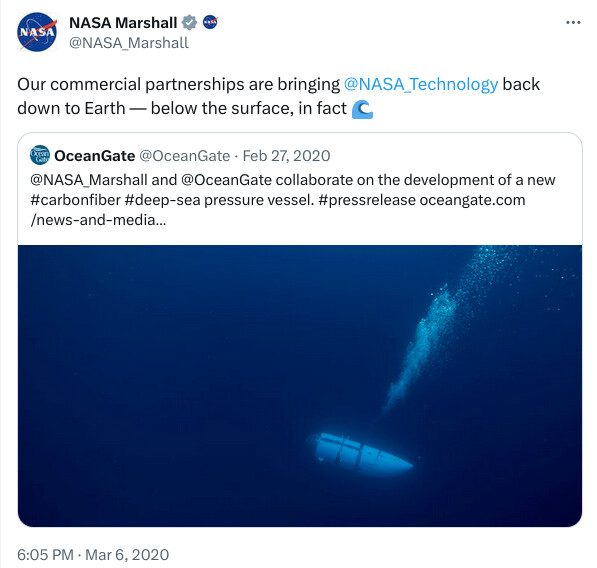For some reason, the link to the press release on the OceanGate site is failing with a CloudFlare 525 error (SSL handshake failed). However, GeekWire picked up the press release and ran this article on 2020-02-26:
The agreement calls for NASA’s Marshall Space Flight Center in Alabama to serve as the site for developing and manufacturing a new type of aerospace-grade hull.
OceanGate said the joint design effort will be key to its plans for building a five-person submersible capable of going as deep as 6,000 meters (19,800 feet). If the company can stick to its current timetable, such a submersible would go into service next year and take on a series of dives to the wreck of the Titanic, at a depth of 12,500 feet in the North Atlantic.
“We continue to receive more demand for Titanic, deep-sea research and environmental supervision of deep-sea mining missions that very few submersibles in the world have the capability of supporting,” OceanGate CEO Stockton Rush said in a news release. “NASA’s advanced composite manufacturing capability is ideally suited for the high precision and high-quality requirements of our hull design.”
NASA also aims to benefit from the partnership as it looks into new breeds of pressurized spacecraft and space habitats for use in Earth orbit and beyond.
“NASA is committed to cutting-edge composites research and development that will not only further our deep-space exploration goals, but will also improve materials and manufacturing for American industry,” said John Vickers, principal technologist for advanced manufacturing technology at NASA. “This Space Act Agreement with OceanGate is a great example of how NASA partners with companies to bring space technology back down to Earth.”
Rush said OceanGate would be paying NASA for its services.
“To have NASA accept the project, it had to meet several requirements, such as advancing technology and being not readily available from commercial sources,” Rush told GeekWire in an email.
Over the past couple of years, OceanGate spent millions of dollars building a carbon-hulled submersible known as Titan, which the company hoped would be capable of diving to the Titanic. However, validation tests conducted at the Deep Ocean Test Facility in Maryland found signs of fatigue in the hull, resulting in a depth rating that ruled out Titanic trips.
From 2022-03-09, PRWeb reported:
OCEANGATE, INC worked in consultation with a team of engineers at NASA’s Marshall Space Flight Center in Huntsville, Alabama throughout the development and manufacturing of Titan, the world’s only carbon fiber and titanium submersible capable of carrying five crew members to the wreck of the RMS Titanic at 3,800 meters. This achievement marks the beginning of a new era of exploration offering a vast range of opportunities for deep-sea investigation and scientific research.
As shared in the NASA Analog Fact Sheet: One of the most extreme environments on Earth is the ocean. Not only is the ocean harsh and unpredictable, it also provides many parallels to the challenges of living and working in space.
NASA’s collaboration with OceanGate was made possible through the Space Act. The Space Act was designed to benefit both NASA’s diverse missions, including the Artemis program and future exploration initiatives, and organizations like OceanGate.
“NASA’s expertise in the design and automated fiber placement lay up of composite hulls was extremely valuable on this project,” says Stockton Rush, Chief Executive Officer and Founder, OceanGate, Inc. “The ability to construct Titan’s pressure hull with aerospace grade carbon fiber and manufacturing protocols results in a submersible which weighs a fraction of what other deep diving crewed submersibles weigh. This weight reduction allows us to carry a significantly greater payload which we use to carry five crewmembers: a pilot, researchers, and mission specialists. Titan represents a consequential step forward for human exploration of the ocean which few realize constitutes 99% of Earth’s livable volume.”
NASA Space Shuttle Astronaut, Dr. Scott Parazynski provides additional perspective: “Exploration of our deep oceans is imperative to gaining a better understanding of our blue planet. Spending many weeks in space as a NASA astronaut looking down upon our planet gave me a deeper appreciation for the fragility of our planet,” says Dr. Scott Parazynski, OceanGate submersible pilot-in-training. “In 2021, I had the wonderful opportunity to dive to the Titanic site as an OceanGate Expeditions crewmember. This cutting-edge submersible technology has the power to change the way we explore our deep oceans and understand our planet. I look forward to our second expedition this summer,” continues Parazynski.
